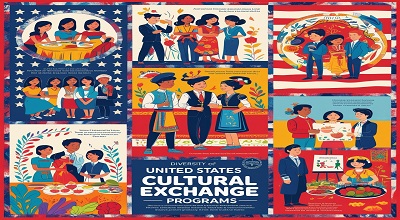United States Cultural Exchange Programs
United States Cultural Exchange Programs: Cultural exchange programs play a crucial role in fostering mutual understanding, strengthening diplomatic ties, and promoting global collaboration. The United States has been a leader in facilitating such programs, offering numerous opportunities for students, professionals, and artists to engage in cross-cultural experiences.
This article explores the latest U.S. cultural exchange programs, their significance, and real-world examples. Whether you’re a student, educator, or professional, this guide will help you understand how these programs work and how you can participate.
What Are Cultural Exchange Programs?
Cultural exchange programs are initiatives designed to promote international understanding by allowing individuals to live, study, or work in another country. These programs encourage participants to immerse themselves in different cultures, learn new languages, and develop global perspectives.
The U.S. government, along with private organizations, sponsors various exchange programs targeting different demographics, including students, teachers, professionals, and artists.
Importance of Cultural Exchange Programs
- Promote Global Understanding: Helps break stereotypes and fosters mutual respect.
- Enhance Education and Skills: Provides access to world-class training and academic opportunities.
- Strengthen Diplomatic Relations: Builds people-to-people connections that support international cooperation.
- Boost Career Prospects: Enhances resumes with international experience and cross-cultural competencies.
Types of U.S. Cultural Exchange Programs
A. Government-Sponsored Programs
Funded by the U.S. Department of State and other federal agencies, these programs focus on diplomacy and education.
B. Private and Non-Profit Programs
Organizations like AFS, CIEE, and Rotary International run exchange initiatives for students and professionals.
C. Academic and Professional Exchange Programs
These include university partnerships, research collaborations, and professional training programs.
Examples of U.S. Cultural Exchange Programs
1. Fulbright Program
- Description: One of the most prestigious exchange programs, offering scholarships for students, scholars, and professionals.
- Eligibility: Varies by country; typically requires a bachelor’s degree.
- Latest Update: Expanded virtual exchange options post-pandemic.
2. International Visitor Leadership Program (IVLP)
- Description: Brings emerging leaders to the U.S. for short-term professional visits.
- Eligibility: Nominated by U.S. embassies.
3. Youth Exchange and Study (YES) Program
- Description: Provides scholarships for high school students from predominantly Muslim countries.
- Latest Update: Increased focus on STEM education.
4. Work and Travel USA
- Description: Allows international university students to work in the U.S. during summer breaks.
5. Au Pair Program
- Description: Offers young adults the chance to live with American families while providing childcare.
6. Kennedy-Lugar YES Abroad
- Description: American students study abroad in countries with significant Muslim populations.
7. Community College Initiative Program
- Description: Provides vocational training at U.S. community colleges for international students.
8. Critical Language Scholarship (CLS) Program
- Description: Intensive language training in critical-need languages like Arabic, Chinese, and Russian.
Latest Updates on U.S. Cultural Exchange Programs
- Post-Pandemic Adjustments: More hybrid and virtual exchange options.
- Increased Diversity Initiatives: Focus on underrepresented regions.
- Tech-Driven Exchanges: Use of AI and virtual reality for immersive learning.
How to Apply for U.S. Cultural Exchange Programs?
- Research programs matching your profile.
- Check eligibility and deadlines.
- Prepare required documents (essays, recommendations, language tests).
- Submit applications through official portals.
Challenges and Benefits
Challenges:
- Visa restrictions
- Cultural adjustment difficulties
- High competition
Benefits:
- Career advancement
- Personal growth
- Networking opportunities
Success Stories
- Example 1: A Fulbright scholar who became a diplomat.
- Example 2: A YES program alumna leading a global NGO.
Future of U.S. Cultural Exchange Programs
- Greater emphasis on digital exchanges.
- Expansion to more countries.
- Increased public-private partnerships.
Conclusion
U.S. cultural exchange programs remain vital for global engagement. Whether through government or private initiatives, these programs open doors to life-changing experiences.
FAQs
1. What is the most popular U.S. cultural exchange program?
The Fulbright Program is the most renowned, offering opportunities in over 160 countries.
2. Can high school students participate in exchange programs?
Yes, programs like YES Abroad and AFS Intercultural Programs cater to high school students.
3. Are there paid cultural exchange programs?
Some, like Work and Travel USA, offer paid work opportunities.
4. How competitive are these programs?
Highly competitive, especially Fulbright and CLS. Strong academic and professional backgrounds improve chances.
5. Can exchange programs lead to U.S. residency?
While they don’t directly provide residency, they can enhance visa prospects for future studies or employment.
Visit Right Now: Special Forces Group 2 APK
